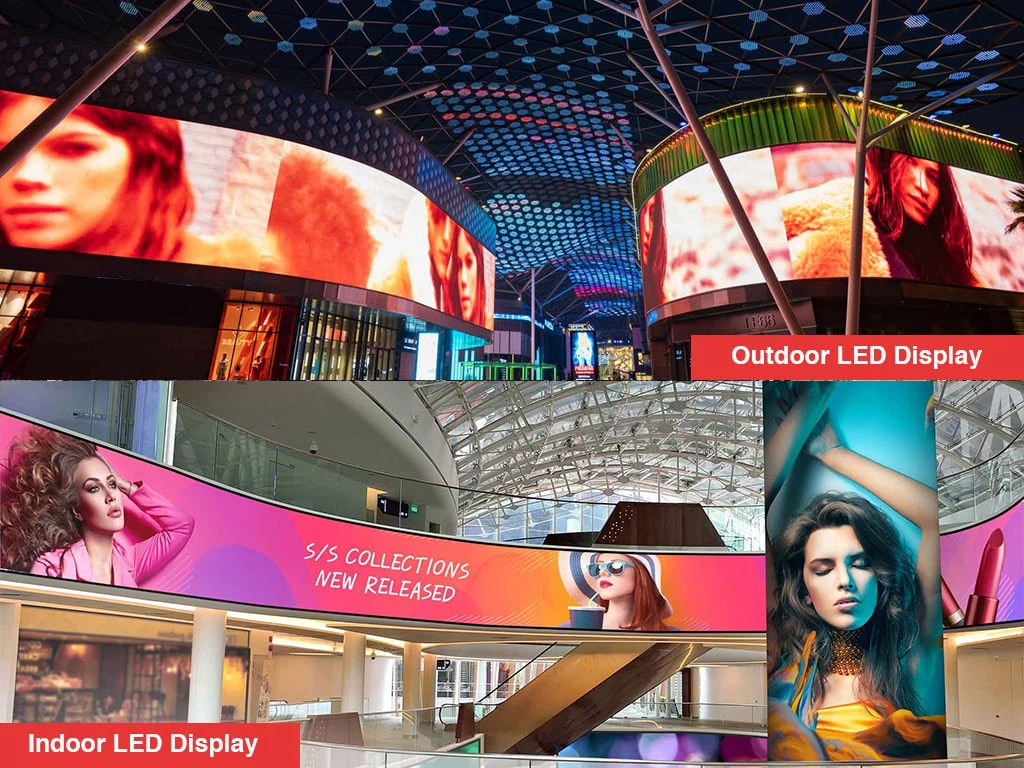Outdoor LED displays are flat screens used outdoors, typically ranging from tens to hundreds of square meters in size. They feature high brightness, allowing for normal use even in direct sunlight, and are designed to be windproof, rainproof, and waterproof. In contrast, indoor LED displays are used inside. So, what exactly are the differences between outdoor and indoor LED displays?
What is an Indoor LED Display?
Indoor LEDs, as the name suggests, are medium to large LED display devices used indoors. Examples include bank counters and supermarket promotional displays, which are commonly seen. The area of indoor LED displays can range from one square meter to over ten square meters. Due to their higher pixel density, the performance of indoor LED displays is slightly lower than that of outdoor displays.
What is an Outdoor LED Display?
Outdoor LED displays are screens used outside. They have significantly higher brightness than indoor displays, often dozens of times brighter. Additionally, outdoor LED displays have excellent waterproof and heat dissipation features, which are important details that installation technicians need to explain to users.
Furthermore, outdoor LED advertising screens have a much larger luminous area compared to indoor displays. This also brings challenges related to power consumption, maintenance, and lightning protection. Therefore, maintaining outdoor LED advertising screens is not easy, which is a key reason for our frequent after-sales service efforts.
Semi-outdoor LED displays are generally installed on storefronts to disseminate information and are used in commercial advertising. Their pixel size falls between indoor and outdoor displays and is commonly seen in bank, mall, or hospital facades. Semi-outdoor LED displays have high brightness and can be used outdoors without direct sunlight. Due to good sealing, they are usually installed under eaves or inside windows.
How to Distinguish Between Outdoor and Indoor Displays?
For users, how can they better distinguish between these two types of LED displays? By observing their appearance. Generally, outdoor displays are larger and have denser pixels with higher brightness. This issue can also be resolved with the help of maintenance personnel. Overall, choosing a reliable LED display manufacturer can save a lot of time and facilitate future maintenance.
In general, both indoor and outdoor displays have a wide range of applications. With their high brightness, low operating voltage, low power consumption, large size, long lifespan, impact resistance, and stable performance, LED displays bring great convenience to our lives. Indoor and outdoor LED displays are expected to play even more important roles in the future market, mainly in the following areas:
Features
First, let’s talk about indoor LED displays. Traditionally, indoor LED displays are surface-mounted, characterized by high clarity and vibrant colors, but their downside is that they tend to be more expensive.
Outdoor displays primarily use plug-in lamps, while indoor displays are mostly surface-mounted. Due to strong outdoor sunlight, outdoor LED displays are generally brighter than indoor ones. The features of outdoor and semi-outdoor module unit boards include high brightness, waterproofing, and rich colors, but they require technical guidance for installation.
Brightness
Indoor unit boards used outdoors will not meet brightness requirements and may appear dull, as their brightness is significantly lower than that of outdoor LED unit boards. Conversely, outdoor unit boards used indoors may be too bright, so it’s best to use indoor unit boards for indoor applications.
Waterproofing
The surface of outdoor products must be waterproof, so outdoor displays are constructed with waterproof enclosures. Waterproofing is a critical consideration for outdoor displays. Indoor displays can be made with or without enclosures. If an outdoor enclosure is simple and inexpensive, its waterproofing may not be adequate, so the enclosure’s edges must be sealed properly. Generally, these enclosures are filled with adhesive, whereas indoor displays do not have this feature.
Installation
Depending on the user’s environment, there are various installation methods for LED displays, including wall-mounted, cantilever, embedded, upright, standing, rooftop, mobile, and curved installations. Indoor installations are generally straightforward, with fewer styles and a relatively simple setup. In contrast, outdoor LED displays present greater installation challenges and higher risks.
Price
Indoor LED displays typically have a closer viewing distance, so their higher clarity comes at a higher price compared to outdoor LED displays. Outdoor displays generally have a farther viewing distance, and excessive clarity may hinder visibility. Thus, the price differences among various models of LED displays are normal, as they are customized based on actual viewing distances.
Post time: Sep-23-2024

